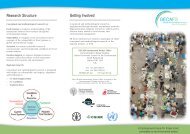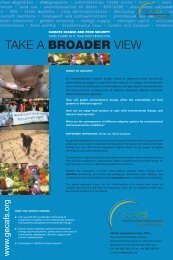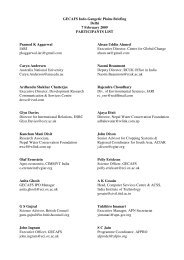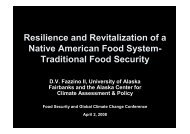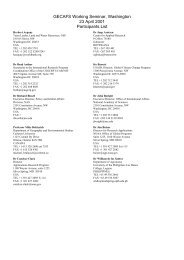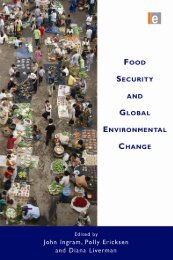From Food Production to Food Security - Global Environmental ...
From Food Production to Food Security - Global Environmental ...
From Food Production to Food Security - Global Environmental ...
- No tags were found...
You also want an ePaper? Increase the reach of your titles
YUMPU automatically turns print PDFs into web optimized ePapers that Google loves.
deforestation while ensuring that those living in poverty benefit from nature’s environmental servicesand achieve food security.A partnership of institutions around the world, including research institutes, non-governmentalorganizations, universities, community organizations, and farmers’ groups, ASB operates as amultidisciplinary consortium for research, development and capacity-building. ASB applies anintegrated natural resource management (iNRM) approach <strong>to</strong> analysis and action (Izac and Sanchez,2001) through long-term engagement with local communities and policy-makers.ASB undertakes participa<strong>to</strong>ry research and development of technological, institutional and policyinnovations <strong>to</strong> raise productivity and income of poor rural households in the humid tropics whilstslowing down deforestation and enhancing essential environmental services. Poverty reduction in thehumid tropics depends on finding ways <strong>to</strong> raise productivity of labour and land, often throughintensification of smallholder production activities. Although there are some opportunities <strong>to</strong> reducepoverty while conserving tropical forests, tropical deforestation typically involves tradeoffs amongthe concerns of poor households, national development objectives and the environment (De Fries etal., 2004; Palm et al., 2005). ASB partners work with households <strong>to</strong> understand their problems andopportunities. Similarly, consultations with local and national policy-makers bring in their distinctiveinsights. In this way, participa<strong>to</strong>ry research and policy consultations have been guiding the iterativeprocess necessary <strong>to</strong> identify, develop and implement combinations of policy, institutional andtechnological options that are workable and relevant.The participa<strong>to</strong>ry on-farm work is undertaken at ASB ‘benchmark’ sites, established in each of theregions. These are areas (roughly 100 km 2 ) of long-term (i.e. more than 10 years) study andengagement by partners with households, communities, and policy-makers at various levels. Allbenchmark sites are in the humid tropical and subtropical broadleaf forest biome (as mapped byWWF, the World Wide Fund for Nature). The most biologically diverse terrestrial biome by far,conversion of these forests leads <strong>to</strong> the greatest species loss per unit area of any land cover change.ASB focuses on the landscape mosaics (comprising both forests and agriculture) where globalenvironmental problems and poverty coincide. ASB’s multisite network helps <strong>to</strong> ensure that analysesof local and national perspectives, and the search for alternatives, are grounded in reality.An analysis of the lessons learned in ASB shows that the importance of team- and networkbuildingat each one of the ‘benchmark sites’ cannot be overstressed. Much care was taken inthe selection of research sites representative of the major regions, globally, where slash-andburnagriculture is important. Each site thus encompasses a broad range of biophysical andsocio-economic conditions and is representative of conditions prevailing throughout differentregions. Standardized methods for site characterization and for undertaking both biophysicaland socio-economic research at each site were designed and discussed with the multiinstitutionaland interdisciplinary teams at each benchmark site. The core team of scientistswho conceived the research agenda of ASB, which includes the need <strong>to</strong> work in parallel indifferent sites representative of a range of regional conditions, did not however foresee howdifficult the initial team- and network-building was going <strong>to</strong> be. Even though all theinstitutions involved subscribed <strong>to</strong> the ASB research agenda, and had been attracted <strong>to</strong> theASB Consortium because they found this research agenda compelling, teams at each site <strong>to</strong>ok93



